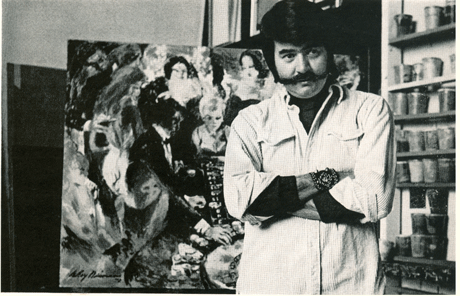
LeRoy Neiman died yesterday. He was 91.
“Dying for Art’s Sake,” is an essay Pete Dexter wrote about Neiman for Esquire in July, 1984. It is reprinted here with permission from the author.

LeRoy Neiman has just been murdered in Milwaukee.
The clipping came in the morning mail—he thinks it was from Milwaukee—a review of his new book of paintings and sketches. “I don’t know why people aren’t nice,” he says. I am talking to him on the phone now. “Are you nice? Listen, there have been thousands of pictures taken of me. I’m a reasonably good-looking human being, aren’t I? Why would an editor want to use a picture where I have an hors d’oeuvre sticking out of my cheek? I wouldn’t do that to him. I always make things look their best…”
“That’s Milwaukee for you,” I admit.
“No, that was a newspaper. The guy in Milwaukee was very clever. He quoted every bad thing anybody ever said about me, but didn’t really say anything himself…Hotel room paintings. What’s wrong with paintings in hotel rooms? A lot of my paintings are in hotel rooms, so what? Art is where you find it. Oh, and they criticized my chin. Did I tell you that? They said I had a weak chin.”
“In Milwaukee?”
“No, in the newspaper. If you’re feeling nice, perhaps it would be amusing to visit, but I don’t need criticism. So if you’re not nice…”

I tell LeRoy I will try to write nice, but I can’t promise. He invites me up to his place in New York anyway. The place in New York is most of the third floor of a large apartment building across the street from Central Park. There is an efficient-looking woman with the purest features I ever saw—one of those noses that looks like somebody took two weeks to get the flare in the nostrils right—who seems to run things for him, jars of paint and brushes all over the place, walls covered with painting and prints and sketches, most of them of athletes. There is a giant oil representation of a Las Vegas crap table learning against the far wall, done almost entirely in red. Floors, background, faces, clothes.
I haven’t done a lot of painting myself, unless you count water towers, but I recognize a work in progress. I figure he does all the blues next, then the yellows or whites. I figure, what he’s got there is a primer coat.

“That’s not finished, is it?” I say.
LeRoy seems pleased I have intuited that.
“No,” he says. “I haven’t decided what to do with it yet.”
“Well,” I say, “I think you’ve about done what you can with the red.”
The phone rings then, and the woman answers it. “LeRoy,” she says, “I’m sorry to interrupt…”
The call is about appearing in a movie. He takes it in the vestibule, but the acoustics in the place are terrific, and I can hear what he says at least as well as whoever is on the other end. Better, probably, because he keeps having to repeat himself for the other end.

“Yes,” he says, “a thousand a day and expenses…”
He wants a thousand dollars a day instead of a straight fee for the job because it might rain wherever the job is, and he doesn’t want to be sitting around somewhere getting wet for nothing.
He comes back into the studio and I compliment his acoustics. “This place is better than Lincoln Center,” I say.
LeRoy looks around the room, probably misunderstanding what I have said. “I’ve got an apartment on the ninth floor too,” he says. “But I never go up there. There’s furniture and a beautiful view, but it depresses me. And I’ve got a house in Great Gorge, New Jersey, but I haven’t been there in four years. I love the place, I just don’t like to be inside it. I have to keep it, though, you’ve got to have a house in the country.”

It is the pictures of the athletes that have made all this possible. They showed up first in Playboy magazine, which started running LeRoy’s stuff back in the Fifties. Then Roone Arledge of ABC Sports put them on television and turned LeRoy’s work into the most recognizable art in this country. Nobody is exactly sure why.
Eventually, of course, LeRoy became as famous as his pictures. He wore his white hats and trained his moustache to grow almost to his ears, and he had fascinating cigars.
I don’t know how he does it, but LeRoy’s cigars are always two minutes old. He carries them in the left side of his mouth, and they are always long and dark with half an inch of cold ash at the end. Then some wiseass editor in Milwaukee runs a picture of him eating hors d’oeuvres.
And you wonder why artists are moody?
II
“I like being outrageous,” he says. “It is the worst possible thing for my income and standing in the art community, but I don’t care. Why should I behave myself now, after all these years?”

I ask LeRoy what kind of misbehaving he means. Does he give sheep for wedding presents? Has he gotten drunk at parties and tired to deliver babies? He shakes his head no.
“I don’t actually do anything,” he says, “except be conspicuous. It keeps me revved up.”
The phone rings again. The woman answers it. “LeRoy,” she says, “I’m sorry to interrupt…” This time it’s some Brazilians, wanting him to come to a party at Regine’s.
“Everybody always wants things from me,” he says after he has hung up.

The Brazilians, it turns out—at least these Brazilians—are economically advantaged people. LeRoy says they wear the best clothes and drink at the best clubs and introduce all the new trends.
“They amuse me,” he says, “but I am not one of them. I am part of their scene—the same three hundred people show up everywhere around the world—but I’m not a member. I never judge them, I am never shocked by their conduct.” He sees I don’t understand. “A lot of them steal,” he says.
That’s the same way it is with LeRoy and athletes. “I don’t get too close to them personally,” he says. And this reminds him of the safari with Hef.
Hef is Hugh Hefner, who owns Playboy. He is one of the three people LeRoy names when I ask who his friends are. The other two are artists he sees once every two or three years.

“It was while we were in Africa,” he says, “that I noticed the natives were always jumping. Any little noise, they’d jump. They watched each other every minute. Hef and I and four other guys and six chicks went around the world to break in the new plane. You know, a pleasure trip. But in Africa, I saw these jumpy natives and realized that danger makes you aware. That’s how I am, too. Aware, observant. Nothing can sneak up from behind. That allows you to be outrageous.”
“You see, you come to a moment sometimes when you know you shouldn’t do something but you take the chance and do it anyway. The moment occurs in sports, it occurs in art. That’s the moment of creation, taking the chance. And sometimes it comes out fine, and sometimes you get murdered.”

I notice, however, that his paintings aren’t about the moment, they depict the population of a best-possible world.
“I like things to their best,” he says. “I like beautiful things, like chandeliers. But I think, for instance, you can say as much about war by painting the enthusiastic young soldiers marching off as you can by showing the dismembered bodies.”
I ask, “Where is the chance in that?”
LeRoy leans closer. “Have you ever heard of Mad Dog Vachon?” he says. “Andre the Giant? They’re wrestlers. Very big people, and very crude. A person I know called and asked if I would come to Ottawa, Canada, and sketch wrestling. They were doing a telecast, and wanted me at ringside to give it credibility.”

“So I flew to Montreal and we took a limousine—you’ve got to insist on a limo and the best room or else they’ll take advantage of you—and we drove about one hundred miles to the arena. I had a chick with me—a magnificent animal—and they put us right at ringside.
“The man who arranged for me to be there had told me that Mad Dog would point at me and call me names as part of the show. After the wrestlers were introduced, Mad Dog pretended to suddenly notice me sitting there, and he yelled, ‘I want that man removed. I want to see what he’s drawing.’
“I turned to the chick and said, ‘He’s really good.’ Then Mad Dog reached through the ropes and grabbed my leather drawing pad. I take it everywhere, and nobody is allowed to do that. I tried to pull it back. I said, ‘All right, that’s enough. These are my sketches,’ but Mad Dog pulled the pad and me with it right out of my seat, and then he crumpled up all my drawings.”
And you wonder why artists are so moody.
LeRoy says, “I yelled at him then that he had gone too far. He picked me up over his head and began whirling me around and around, the crowd went crazy, and then he finally threw me on the floor. That’s how wrestlers take criticism. I picked up my things and told the woman I was with that they had gone too far. We went back to the dressing room to complain, and after a while Mad Dog came in and said, ‘I didn’t do nothin’.’ Unbelievably crude.
“Then we went back to the limousine and two of the wrestlers followed us out and asked for a ride back to Montreal. One of them sat on the set with us, the other one sat on the jump seat. Huge, bruised men. We got about halfway to Montreal and one of them said, ‘We got to stop and eat.’
“I said I wanted to get back to Montreal. They said no, we had to stop. I refused. They seemed very civilized until we went by the truck stop and one them looked outside and said, ‘You remember the night we cleaned that place out?’…”
LeRoy sits quietly, in the middle of the memory. “I don’t associate with crude people,” he says after a while. “I came from a broken home and poverty, and I don’t want to be around that now. I am a working man’s artist, but I don’t know any working me. I champion their cause, but I don’t have any of them I talk to.”
“Why not?” I ask.
He shakes his head. “I don’t have to,” he says. “I’m an artist, and I can do what I want.”

[Mad Dog Vachon picture by Hieram Weintraub]

















